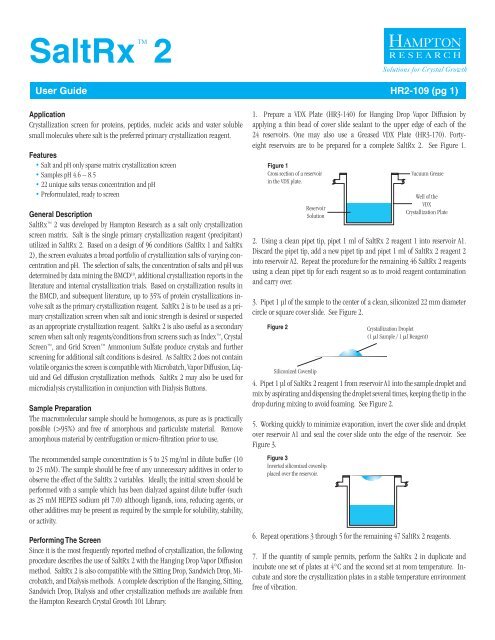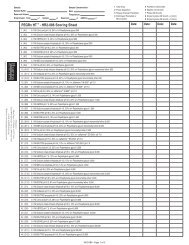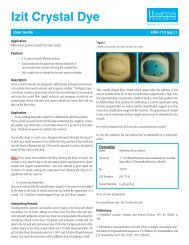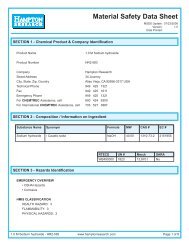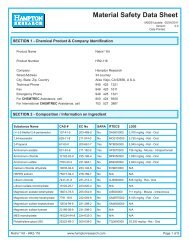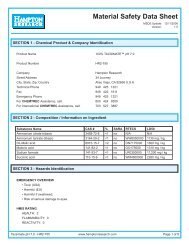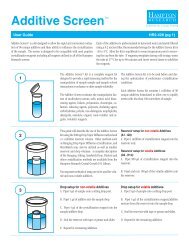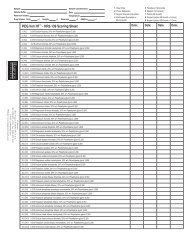SaltRx 2 User Guide HR2-109 - Hampton Research
SaltRx 2 User Guide HR2-109 - Hampton Research
SaltRx 2 User Guide HR2-109 - Hampton Research
You also want an ePaper? Increase the reach of your titles
YUMPU automatically turns print PDFs into web optimized ePapers that Google loves.
<strong>SaltRx</strong>TM2Solutions for Crystal Growth<strong>User</strong> <strong>Guide</strong> <strong>HR2</strong>-<strong>109</strong> (pg 1)ApplicationCrystallization screen for proteins, peptides, nucleic acids and water solublesmall molecules where salt is the preferred primary crystallization reagent.Features• Salt and pH only sparse matrix crystallization screen• Samples pH 4.6 – 8.5• 22 unique salts versus concentration and pH• Preformulated, ready to screenGeneral Description<strong>SaltRx</strong> 2 was developed by <strong>Hampton</strong> <strong>Research</strong> as a salt only crystallizationscreen matrix. Salt is the single primary crystallization reagent (precipitant)utilized in <strong>SaltRx</strong> 2. Based on a design of 96 conditions (<strong>SaltRx</strong> 1 and <strong>SaltRx</strong>2), the screen evaluates a broad portfolio of crystallization salts of varying concentrationand pH. The selection of salts, the concentration of salts and pH wasdetermined by data mining the BMCD 10 , additional crystallization reports in theliterature and internal crystallization trials. Based on crystallization results inthe BMCD, and subsequent literature, up to 35% of protein crystallizations involvesalt as the primary crystallization reagent. <strong>SaltRx</strong> 2 is to be used as a primarycrystallization screen when salt and ionic strength is desired or suspectedas an appropriate crystallization reagent. <strong>SaltRx</strong> 2 is also useful as a secondaryscreen when salt only reagents/conditions from screens such as Index , CrystalScreen , and Grid Screen Ammonium Sulfate produce crystals and furtherscreening for additional salt conditions is desired. As <strong>SaltRx</strong> 2 does not containvolatile organics the screen is compatible with Microbatch, Vapor Diffusion, Liquidand Gel diffusion crystallization methods. <strong>SaltRx</strong> 2 may also be used formicrodialysis crystallization in conjunction with Dialysis Buttons.Sample PreparationThe macromolecular sample should be homogenous, as pure as is practicallypossible (>95%) and free of amorphous and particulate material. Removeamorphous material by centrifugation or micro-filtration prior to use.The recommended sample concentration is 5 to 25 mg/ml in dilute buffer (10to 25 mM). The sample should be free of any unnecessary additives in order toobserve the effect of the <strong>SaltRx</strong> 2 variables. Ideally, the initial screen should beperformed with a sample which has been dialyzed against dilute buffer (suchas 25 mM HEPES sodium pH 7.0) although ligands, ions, reducing agents, orother additives may be present as required by the sample for solubility, stability,or activity.Performing The ScreenSince it is the most frequently reported method of crystallization, the followingprocedure describes the use of <strong>SaltRx</strong> 2 with the Hanging Drop Vapor Diffusionmethod. <strong>SaltRx</strong> 2 is also compatible with the Sitting Drop, Sandwich Drop, Microbatch,and Dialysis methods. A complete description of the Hanging, Sitting,Sandwich Drop, Dialysis and other crystallization methods are available fromthe <strong>Hampton</strong> <strong>Research</strong> Crystal Growth 101 Library.1. Prepare a VDX Plate (HR3-140) for Hanging Drop Vapor Diffusion byapplying a thin bead of cover slide sealant to the upper edge of each of the24 reservoirs. One may also use a Greased VDX Plate (HR3-170). Fortyeightreservoirs are to be prepared for a complete <strong>SaltRx</strong> 2. See Figure 1.Figure 1Cross section of a reservoirin the VDX plate.2. Using a clean pipet tip, pipet 1 ml of <strong>SaltRx</strong> 2 reagent 1 into reservoir A1.Discard the pipet tip, add a new pipet tip and pipet 1 ml of <strong>SaltRx</strong> 2 reagent 2into reservoir A2. Repeat the procedure for the remaining 46 <strong>SaltRx</strong> 2 reagentsusing a clean pipet tip for each reagent so as to avoid reagent contaminationand carry over.3. Pipet 1 µl of the sample to the center of a clean, siliconized 22 mm diametercircle or square cover slide. See Figure 2.Figure 2ReservoirSolutionSiliconized CoverslipVacuum GreaseWell of theVDXCrystallization Plate4. Pipet 1 µl of <strong>SaltRx</strong> 2 reagent 1 from reservoir A1 into the sample droplet andmix by aspirating and dispensing the droplet several times, keeping the tip in thedrop during mixing to avoid foaming. See Figure 2.5. Working quickly to minimize evaporation, invert the cover slide and dropletover reservoir A1 and seal the cover slide onto the edge of the reservoir. SeeFigure 3.Figure 3Inverted siliconized coverslipplaced over the reservoir.Crystallization Droplet(1 ml Sample / 1 ml Reagent)6. Repeat operations 3 through 5 for the remaining 47 <strong>SaltRx</strong> 2 reagents.7. If the quantity of sample permits, perform the <strong>SaltRx</strong> 2 in duplicate andincubate one set of plates at 4°C and the second set at room temperature. Incubateand store the crystallization plates in a stable temperature environmentfree of vibration.
<strong>SaltRx</strong>TM2Solutions for Crystal Growth<strong>User</strong> <strong>Guide</strong> <strong>HR2</strong>-<strong>109</strong> (pg 2)Figure 4Typical observations in acrystallization experimentClear DropSkin /PrecipitatePrecipitatePrecipitate /PhaseQuasiCrystalsMicrocrystalsNeedleClusterPlatesRod ClusterSingleCrystalExamine The DropCarefully examine the drops under a stereo microscope (10 to100x magnification) immediately after setting up the screen. Recordall observations and be particularly careful to scan the focalplane for small crystals. Observe the drops once each day for thefirst week, then once a week there after. Records should indicatewhether the drop is clear, contains precipitate, and or crystals. Itis helpful to describe the drop contents using descriptive terms.Adding magnitude is also helpful. Example: 4+ yellow/brownfine precipitate, 2+ small bipyramid crystals, clear drop, 3+ needleshaped crystals in 1+ white precipitate. One may also employa standard numerical scoring scheme (Clear = 0, Precipitate = 1,Crystal = 10, etc). Figure 4 shows typical examples of what onemight observe in a crystallization experiment.Interpreting <strong>SaltRx</strong> 2Clear drops indicate that either the relative supersaturation of thesample and reagent is too low or the drop has not yet completedequilibration. If the drop remains clear after 3 to 4 weeks considerrepeating the <strong>SaltRx</strong> 2 condition and doubling the sampleconcentration. If more than 70 of the 96 <strong>SaltRx</strong> 2 drops are clearconsider doubling the sample concentration and repeating theentire screen.Drops containing precipitate indicate that either the relative supersaturationof the sample and reagent is too high, the samplehas denatured, or the sample is heterogeneous. To reduce therelative supersaturation, dilute the sample twofold and repeat the<strong>SaltRx</strong> 2 condition. If more than 70 of the 96 <strong>SaltRx</strong> 2 dropscontain precipitate and no crystals are present, consider dilutingthe sample concentration in half and repeating the entire screen.If sample denaturation is suspect, take measures to stabilize thesample (add reducing agent, ligands, glycerol, salt, or other stabilizingagents). If the sample is impure, aggregated, or heterogeneoustake measures to pursue homogeneity. It is possible toobtain crystals from precipitate so do not discard nor ignore adrop containing precipitate. If possible, examine drops containingprecipitate under polarizing optics to differentiate precipitatefrom microcrystalline material.If the drop contains a macromolecular crystal the relative supersaturationof the sample and reagent is appropriate for crystallization.The next step is to optimize the preliminary conditions(pH, salt type, salt concentration, precipitant type, precipitantconcentration, sample concentration, temperature, additives, andother crystallization variables) which produced the crystal in orderto improve crystal size and quality.Compare the observations between the 4°C and room temperatureincubation to determine the effect of temperature on samplesolubility.Different results in the same drops at different temperatures indicatethat sample solubility is temperature dependent and that oneshould include temperature as a variable in subsequent screensand optimization experiments.Retain and observe plates until the drops are dried out. Crystalgrowth can occur within 15 minutes or one year.<strong>SaltRx</strong> 2 Formulation<strong>SaltRx</strong> 2 reagents are formulated using the highest purity chemicals,ultrapure water (18.2 Megohm-cm, 5 ppb TOC) and are sterilefiltered using 0.22 micron filters into sterile containers (nopreservatives added).<strong>SaltRx</strong> 2 reagents are readily reproduced using <strong>Hampton</strong> <strong>Research</strong>Optimize stock solutions of salts, polymers and buffers.Optimize stock reagents make reproducing <strong>SaltRx</strong> 2 reagents fast,convenient and easy. Dilutions can be performed directly into thecrystallization plate using Optimize stock reagents.<strong>SaltRx</strong> 2 reagents containing buffers are formulated by creatinga 1.0 M stock buffer, titrated to the desired pH using hydrochloricacid or sodium hydroxide. The buffer is then diluted with theother reagent components and water. No further pH adjustmentis required.<strong>SaltRx</strong> 2 reagents are stable at room temperature and are best ifused within 12 months of receipt.If the sample contains phosphate, borate, or carbonate buffers itis possible to obtain inorganic crystals (false positives) when using<strong>SaltRx</strong> 2 reagents containing divalent cations. To avoid falsepositives use phosphate, borate, or carbonate buffers at concentrationsof 10 mM or less or exchange the phosphate, borate, orcarbonate buffer with a more soluble buffer that does not complexwith divalent cations such as HEPES sodium.References and Readings1. Crystallization of nucleic acids and proteins, Edited by A. Ducruixand R. Giege, The Practical Approach Series, Oxford Univ.Press, 1992.2. Current approaches to macromolecular crystallization.McPherson, A. Eur. J. Biochem. 189, 1-23, 1990.
<strong>SaltRx</strong>TM2Solutions for Crystal Growth<strong>User</strong> <strong>Guide</strong> <strong>HR2</strong>-<strong>109</strong> (pg 3)3. Sparse Matrix Sampling: a screening method for crystallization of proteins.Jancarik, J. and Kim, S.H. J. Appl. Cryst., 24,409-411, 1991.4. Protein and Nucleic Acid Crystallization. Methods, A Companion to Methodsin Enzymology, Academic Press, Volume 1, Number 1, August 1990.5. A comparison of salts for the crystallization of macromolecules. McPherson,A. Protein Science, 10:418-422, 2001.6. Entering a new phase: Using solvent halide ions in protein structure determination.Dauter, Z. and Dauter, M. Structure, Vol 9, R21-26, Feb 2001.7. Efficiency Analysis of Screening Protocols Used in Protein Crystallization, B.W. Segelke, Journal of Crystal Growth 232 : 553-562 (2001).8. A novel approach to crystallizing proteins under oil. D’Arcy, A. et al. Journalof Crystal Growth, (1996) 168, 175-180.9. Chayen, N. et al, J. Appl. Cryst. (1990) 23, 297.10. Gilliland, G.L., Tung, M., Blakeslee, D.M. and Ladner, J. 1994. The BiologicalMacromolecule Crystallization Database, Version 3.0: New Features, Data,and the NASA Archive for Protein Crystal Growth Data. Acta Crystallogr. D50408-413.Technical SupportInquiries regarding <strong>SaltRx</strong> 2 reagent formulation, interpretation of screen results,optimization strategies and general inquiries regarding crystallization arewelcome. Please e-mail, fax, or telephone your request to <strong>Hampton</strong> <strong>Research</strong>.Fax and e-mail Technical Support are available 24 hours a day. Telephone technicalsupport is available 8:00 a.m. to 5:00 p.m. USA Pacific Standard Time.


